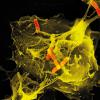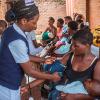We hear from Professor Sunetra Gupta – the theoretical epidemiologist who believes in herd immunity and doesn’t believe in the lockdown.

Professor Sunetra Gupta made the news headlines in March, when she and her colleagues in the Department of Zoology at the University of Oxford ran a predictive model that assumed COVID-19 had arrived in the UK in January – a month earlier than thought. They argued that these extra weeks would have made all the difference, giving the virus enough time to spread to as much as two-thirds of the population, thus achieving a degree of herd immunity. Their research also assumed that only a small proportion of the population, just 0.1%, would be at risk of hospitalisation.
The Oxford model effectively presented a best-case scenario to balance out the worst-case scenario from Imperial College London that had predicted 250,000 to 500,000 deaths in the UK if nothing was done to halt the spread of the disease.
The Imperial model is the one that helped to convince the UK government that a lockdown was the appropriate response to the pandemic.
The Oxford report caused a brief storm, attracting praise and criticism, but was soon lost among the many other COVID storms. But Professor Gupta was back in the news in June, arguing that we ought to have come out of lockdown much sooner – for her, the economic damage being wrought, especially to disadvantaged sections of society, was greater than the impact of the virus.
Looking back on these events from the distance of a few more months, Gupta is standing firmly by her work and her words. “We were not saying that is what had happened, but that it was a possibility. We were laying out a scenario that fitted the data at that point. One scenario, which the Imperial College team had outlined, was that the virus had arrived very recently, had not spread much to the population and had killed a substantial fraction of those infected. And what we were trying to say was equally compatible with the data is this scenario where it arrived earlier.”
Now all the barriers have been removed, it is increasing. I don’t see any surprises in that pattern
A resurgence?
Nothing she has seen since, not even a seeming resurgence of cases, has caused her to reevaluate the scenario. “I don’t think we are seeing a resurgence,” she says. “It’s a useful piece of information to know that lockdown worked in certain areas, to slow down the virus and to stop it from spreading from, say, a town to a village. But as soon as you lift lockdown, the virus comes back.”
So the natural spread of the virus has merely been delayed? “It’s not really a resurgence. It’s just where it didn’t increase in the first place. Now all the barriers have been removed, it is increasing. I don’t see any surprises in that pattern. What I do think is interesting is that it’s not resurgent in many areas that did suffer the full brunt of the pandemic, so in London, New York, northern Italy, Sweden.” For Gupta, this implies that in these areas levels of herd immunity may have been reached, meaning the spread of the virus is now being contained. The key step now, she says, is to use serological testing to determine what proportion of the population has been exposed to COVID-19.
Another factor that interests Gupta is the extent of cross-immunity from exposure to other coronaviruses. “I thought it might protect only against disease, but we’ve learned that these cross-immunity responses can actually protect against infection. That makes it hard to use antibody tests to get a measure of how many people have been exposed to the virus. But the good news is that if a fraction of the population is already resistant to infection, that brings the threshold for herd immunity down substantially.”
Economic vulnerability
If herd immunity is permitted to build, the question of the vulnerable sections of the population becomes even more pressing. “I think the best strategy for protecting the vulnerable is to shield. Obviously mistakes were made in terms of sending infected people back to care homes. I think we should be very careful, especially when we move back into winter. But in many parts of the UK, the infection rates are down to a point where people can make a sensible decision about what level of risk to take.”
She is still no fan of lockdown, even the eased version. “I don’t see any clear and rational thought behind it. More importantly, my primary reason for being vocal has all along been my deep concern about the economically vulnerable, in this country and globally. I am terrified when I read reports of 260 million people going under the poverty line as a result of these measures. We also have to think of the young and what they have been denied.”
Consider all consequences
What then, for her, are the key scientific lessons to be learned so far from the COVID-19 response? “It’s important to put every bit of effort into understanding how the immune response to the virus affects infection, disease, and severe disease. That’s not a huge revelation, but what I hadn’t anticipated was that the cross-protection from other coronaviruses goes much further than expected. Serological surveys are also critical. We’ve been looking at blood banks in Scotland and can see infections going up in mid March, which suggest the virus was there in February. Then there’s the work in the sewers where they’re looking for the virus. I think it’s important to have these sentinels in place to try and see when the virus arrived and where it spread.”
There are also political lessons: “I think it’s important not to look at the situation along the one dimension of ‘how are we going to get this under control?’ We must consider all the consequences. I think we also need to take a more holistic view and not just this individual, nationalistic view. Think globally, think internationally.”
Sunetra Gupta
- Professor of Theoretical Epidemiology at the Department of Zoology, University of Oxford
- 1987 – graduated from Princeton University
- 1992 – PhD, Imperial College London
- 2009 – winner of the Royal Society Rosalind Franklin Award for her scientific achievements
- Author of five fictional novels




